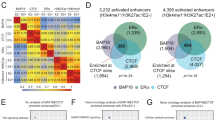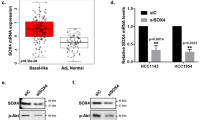Abstract
The SWI/SNF complex participates as a co-activator in the transcriptional regulation of certain genes. Conversely, we and others have recently established that Brg1 and Brm, the central components of SWI/SNF, act instead as co-repressors for E2F-mediated transcriptional repression, and for the transcription of certain other promoters. We report here that Brg-1 and Brm can switch their mode of function at same promoter between activation and repression by ligand-directed differential coordination with BAF155, BAF170, HDAC1, p300 and prohibitin. This ligand and context-dependent reprogramming of the SWI/SNF complex allows it to differentially serve as either a co-repressor or a co-activator of transcription at the same promoter.
This is a preview of subscription content, access via your institution
Access options
Subscribe to this journal
Receive 50 print issues and online access
$259.00 per year
only $5.18 per issue
Buy this article
- Purchase on Springer Link
- Instant access to full article PDF
Prices may be subject to local taxes which are calculated during checkout


Similar content being viewed by others
References
Banchio C, Lingrell S, Vance DE . (2006). Role of histone deacetylase in the expression of CTP:phosphocholine cytidylyltransferase alpha. J Biol Chem 281: 10010–10015.
Belandia B, Orford RL, Hurst HC, Parker MG . (2002). Targeting of SWI/SNF chromatin remodelling complexes to estrogen-responsive genes. EMBO J 21: 4094–4103.
Betz BL, Strobeck MW, Reisman DN, Knudsen ES, Weissman BE . (2002). Re-expression of hSNF5/INI1/BAF47 in pediatric tumor cells leads to G1 arrest associated with induction of p16ink4a and activation of RB. Oncogene 21: 5193–5203.
Boutillier AL, Trinh E, Loeffler JP . (2003). Selective E2F-dependent gene transcription is controlled by histone deacetylase activity during neuronal apoptosis. J Neurochem 84: 814–828.
Brehm A, Kouzarides T . (1999). Retinoblastoma protein meets chromatin. Trends Biochem Sci 24: 142–145.
Brehm A, Miska E, Reid J, Bannister A, Kouzarides T . (1999a). The cell cycle-regulating transcription factors E2F-RB. Br J Cancer 80 (Suppl 1): 38–41.
Brehm A, Miska EA, McCance DJ, Reid JL, Bannister AJ, Kouzarides T . (1998). Retinoblastoma protein recruits histone deacetylase to repress transcription [see comments]. Nature 391: 597–601.
Brehm A, Nielsen SJ, Miska EA, McCance DJ, Reid JL, Bannister AJ et al. (1999b). The E7 oncoprotein associates with Mi2 and histone deacetylase activity to promote cell growth. EMBO J 18: 2449–2458.
Chen J, Archer TK . (2005). Regulating SWI/SNF subunit levels via protein–protein interactions and proteasomal degradation: BAF155 and BAF170 limit expression of BAF57. Mol Cell Biol 25: 9016–9027.
Chi TH, Wan M, Lee PP, Akashi K, Metzger D, Chambon P et al. (2003). Sequential roles of Brg, the ATPase subunit of BAF chromatin remodeling complexes, in thymocyte development. Immunity 19: 169–182.
Chi TH, Wan M, Zhao K, Taniuchi I, Chen L, Littman DR et al. (2002). Reciprocal regulation of CD4/CD8 expression by SWI/SNF-like BAF complexes. Nature 418: 195–199.
Dahiya A, Gavin MR, Luo RX, Dean DC . (2000). Role of the LXCXE binding site in Rb function. Mol Cell Biol 20: 6799–6805.
Dasgupta P, Sun J, Wang S, Fusaro G, Betts V, Padmanabhan J et al. (2004). Disruption of the Rb–Raf-1 interaction inhibits tumor growth and angiogenesis. Mol Cell Biol 24: 9527–9541.
de la Serna IL, Roy K, Carlson KA, Imbalzano AN . (2001). MyoD can induce cell cycle arrest but not muscle differentiation in the presence of dominant negative SWI/SNF chromatin remodeling enzymes. J Biol Chem 276: 41486–41491.
Decristofaro MF, Betz BL, Rorie CJ, Reisman DN, Wang W, Weissman BE . (2001). Characterization of SWI/SNF protein expression in human breast cancer cell lines and other malignancies. J Cell Physiol 186: 136–145.
DeCristofaro MF, Betz BL, Wang W, Weissman BE . (1999). Alteration of hSNF5/INI1/BAF47 detected in rhabdoid cell lines and primary rhabdomyosarcomas but not Wilms' tumors. Oncogene 18: 7559–7565.
DiRenzo J, Shang Y, Phelan M, Sif S, Myers M, Kingston R et al. (2000). BRG-1 is recruited to estrogen-responsive promoters and cooperates with factors involved in histone acetylation. Mol Cell Biol 20: 7541–7549.
Dunaief JL, Strober BE, Guha S, Khavari PA, Alin K, Luban J et al. (1994). The retinoblastoma protein and BRG1 form a complex and cooperate to induce cell cycle arrest. Cell 79: 119–130.
Ferreira R, Naguibneva I, Mathieu M, Ait-Si-Ali S, Robin P, Pritchard LL et al. (2001). Cell cycle-dependent recruitment of HDAC-1 correlates with deacetylation of histone H4 on an Rb-E2F target promoter. EMBO Rep 2: 794–799.
Foster KS, McCrary WJ, Ross JS, Wright CF . (2006). Members of the hSWI/SNF chromatin remodeling complex associate with and are phosphorylated by protein kinase B/Akt. Oncogene 25: 4605–4612.
Fryer CJ, Archer TK . (1998). Chromatin remodelling by the glucocorticoid receptor requires the BRG1 complex. Nature 393: 88–91.
Fujita T, Kobayashi Y, Wada O, Tateishi Y, Kitada L, Yamamoto Y et al. (2003). Full activation of estrogen receptor alpha activation function-1 induces proliferation of breast cancer cells. J Biol Chem 278: 26704–26714.
Fukuoka J, Fujii T, Shih JH, Dracheva T, Meerzaman D, Player A et al. (2004). Chromatin remodeling factors and BRM/BRG1 expression as prognostic indicators in non-small cell lung cancer. Clin Cancer Res 10: 4314–4324.
Goodwin GH . (1997). Isolation of cDNAs encoding chicken homologues of the yeast SNF2 and Drosophila Brahma proteins. Gene 184: 27–32.
Gunawardena RW, Siddiqui H, Solomon DA, Mayhew CN, Held J, Angus SP et al. (2004). Hierarchical requirement of SWI/SNF in retinoblastoma tumor suppressor-mediated repression of Plk1. J Biol Chem 279: 29278–29285.
Hanstein B, Eckner R, DiRenzo J, Halachmi S, Liu H, Searcy B et al. (1996). p300 is a component of an estrogen receptor coactivator complex. Proc Natl Acad Sci USA 93: 11540–11545.
Inayoshi Y, Miyake K, Machida Y, Kaneoka H, Terajima M, Dohda T et al. (2006). Mammalian chromatin remodeling complex SWI/SNF is essential for enhanced expression of the albumin gene during liver development. J Biochem (Tokyo) 139: 177–188.
Jeffy BD, Hockings JK, Kemp MQ, Morgan SS, Hager JA, Beliakoff J et al. (2005). An estrogen receptor-alpha/p300 complex activates the BRCA-1 promoter at an AP-1 site that binds Jun/Fos transcription factors: repressive effects of p53 on BRCA-1 transcription. Neoplasia 7: 873–882.
Lee CH, Murphy MR, Lee JS, Chung JH . (1999). Targeting a SWI/SNF-related chromatin remodeling complex to the beta-globin promoter in erythroid cells. Proc Natl Acad Sci USA 96: 12311–12315.
Lin HY, Hopkins R, Cao HJ, Tang HY, Alexander C, Davis FB et al. (2005). Acetylation of nuclear hormone receptor superfamily members: thyroid hormone causes acetylation of its own receptor by a mitogen-activated protein kinase-dependent mechanism. Steroids 70: 444–449.
Luo RX, Dean DC . (1999). Chromatin remodeling and transcriptional regulation. J Natl Cancer Inst 91: 1288–1294.
Luo RX, Postigo AA, Dean DC . (1998). Rb interacts with histone deacetylase to repress transcription. Cell 92: 463–473.
Magnaghi-Jaulin L, Groisman R, Naguibneva I, Robin P, Lorain S, Le Villain JP et al. (1998). Retinoblastoma protein represses transcription by recruiting a histone deacetylase [see comments]. Nature 391: 601–605.
Margueron R, Duong V, Castet A, Cavailles V . (2004). Histone deacetylase inhibition and estrogen signalling in human breast cancer cells. Biochem Pharmacol 68: 1239–1246.
Matsuda K, Ochiai I, Nishi M, Kawata M . (2002). Colocalization and ligand-dependent discrete distribution of the estrogen receptor (ER)alpha and ERbeta. Mol Endocrinol 16: 2215–2230.
Morris L, Allen KE, La Thangue NB . (2000). Regulation of E2F transcription by cyclin E-Cdk2 kinase mediated through p300/CBP co-activators. Nat Cell Biol 2: 232–239.
Morrison AJ, Sardet C, Herrera RE . (2002). Retinoblastoma protein transcriptional repression through histone deacetylation of a single nucleosome. Mol Cell Biol 22: 856–865.
Muchardt C, Yaniv M . (1993). A human homologue of Saccharomyces cerevisiae SNF2/SWI2 and Drosophila brm genes potentiates transcriptional activation by the glucocorticoid receptor. EMBO J 12: 4279–4290.
Muchardt C, Yaniv M . (1999). The mammalian SWI/SNF complex and the control of cell growth. Semin Cell Dev Biol 10: 189–195.
Muchardt C, Yaniv M . (2001). When the SWI/SNF complex remodels … the cell cycle. Oncogene 20: 3067–3075.
Muchardt C, Bourachot B, Reyes JC, Yaniv M . (1998). ras transformation is associated with decreased expression of the brm/SNF2alpha ATPase from the mammalian SWI–SNF complex. EMBO J 17: 223–231.
Murphy DJ, Hardy S, Engel DA . (1999). Human SWI–SNF component BRG1 represses transcription of the c-fos gene. Mol Cell Biol 19: 2724–2733.
Panteleeva I, Rouaux C, Larmet Y, Boutillier S, Loeffler JP, Boutillier AL . (2004). HDAC-3 participates in the repression of e2f-dependent gene transcription in primary differentiated neurons. Ann NY Acad Sci 1030: 656–660.
Peterson CL, Tamkun JW . (1995). The SWI–SNF complex: a chromatin remodeling machine? Trends Biochem Sci 20: 143–146.
Reisman DN, Strobeck MW, Betz BL, Sciariotta J, Funkhouser Jr W, Murchardt C et al. (2002). Concomitant down-regulation of BRM and BRG1 in human tumor cell lines: differential effects on RB-mediated growth arrest vs CD44 expression. Oncogene 21: 1196–1207.
Roche KC, Wiechens N, Owen-Hughes T, Perkins ND . (2004). The FHA domain protein SNIP1 is a regulator of the cell cycle and cyclin D1 expression. Oncogene 23: 8185–8195.
Roy K, de la Serna IL, Imbalzano AN . (2002). The myogenic basic helix-loop-helix family of transcription factors shows similar requirements for SWI/SNF chromatin remodeling enzymes during muscle differentiation in culture. J Biol Chem 277: 33818–33824.
Shanahan F, Seghezzi W, Parry D, Mahony D, Lees E . (1999). Cyclin E associates with BAF155 and BRG1, components of the mammalian SWI-SNF complex, and alters the ability of BRG1 to induce growth arrest. Mol Cell Biol 19: 1460–1469.
Wang S, Fusaro G, Padmanabhan J, Chellappan SP . (2002a). Prohibitin co-localizes with Rb in the nucleus and recruits N-CoR and HDAC1 for transcriptional repression. Oncogene 21: 8388–8396.
Wang S, Zhang B, Faller DV . (2002b). Prohibitin requires Brg-1 and Brm for the repression of E2F and cell growth. EMBO J 21: 3019–3028.
Wang S, Zhang B, Faller DV . (2004). BRG1/BRM and prohibitin are required for growth suppression by estrogen antagonists. EMBO J 23: 2293–2303.
Wang W, Cote J, Xue Y, Zhou S, Khavari PA, Biggar SR et al. (1996a). Purification and biochemical heterogeneity of the mammalian SWI–SNF complex. EMBO J 15: 5370–5382.
Wang W, Xue Y, Zhou S, Kuo A, Cairns BR, Crabtree GR . (1996b). Diversity and specialization of mammalian SWI/SNF complexes. Genes Dev 10: 2117–2130.
Zhao LH, Ba XQ, Wang XG, Zhu XJ, Wang L, Zeng XL . (2005). BAF complex is closely related to and interacts with NF1/CTF and RNA polymerase II in gene transcriptional activation. Acta Biochim Biophys Sin (Shanghai) 37: 440–446.
Acknowledgements
We thank Dr Srikumar P Chellappan for his continuous support. We thank Dr Junn Yanagisawa for reagents. This work was partially supported by grants from the National Cancer Institute (CA101992 and 1R03CA102940-01), and Susan G Komen Breast Cancer Foundation (BCTR0403163). SW is the recipient of the BUSM Department of Medicine Pilot Project Grant Award and an Aid for Cancer Research grant award.
Author information
Authors and Affiliations
Corresponding author
Additional information
Supplementary Information accompanies the paper on the Oncogene website (http://www.nature.com/onc).
Supplementary information
Rights and permissions
About this article
Cite this article
Zhang, B., Chambers, K., Faller, D. et al. Reprogramming of the SWI/SNF complex for co-activation or co-repression in prohibitin-mediated estrogen receptor regulation. Oncogene 26, 7153–7157 (2007). https://doi.org/10.1038/sj.onc.1210509
Received:
Revised:
Accepted:
Published:
Issue Date:
DOI: https://doi.org/10.1038/sj.onc.1210509
Keywords
This article is cited by
-
P4HA2-induced prolyl hydroxylation suppresses YAP1-mediated prostate cancer cell migration, invasion, and metastasis
Oncogene (2021)
-
GBAF, a small BAF sub-complex with big implications: a systematic review
Epigenetics & Chromatin (2020)
-
Epigenetic regulation of lung cancer cell proliferation and migration by the chromatin remodeling protein BRG1
Oncogenesis (2019)
-
Linking long non-coding RNAs and SWI/SNF complexes to chromatin remodeling in cancer
Molecular Cancer (2017)
-
Effect of estrogen on expression of prohibitin in white adipose tissue and liver of diet-induced obese rats
Molecular and Cellular Biochemistry (2015)



